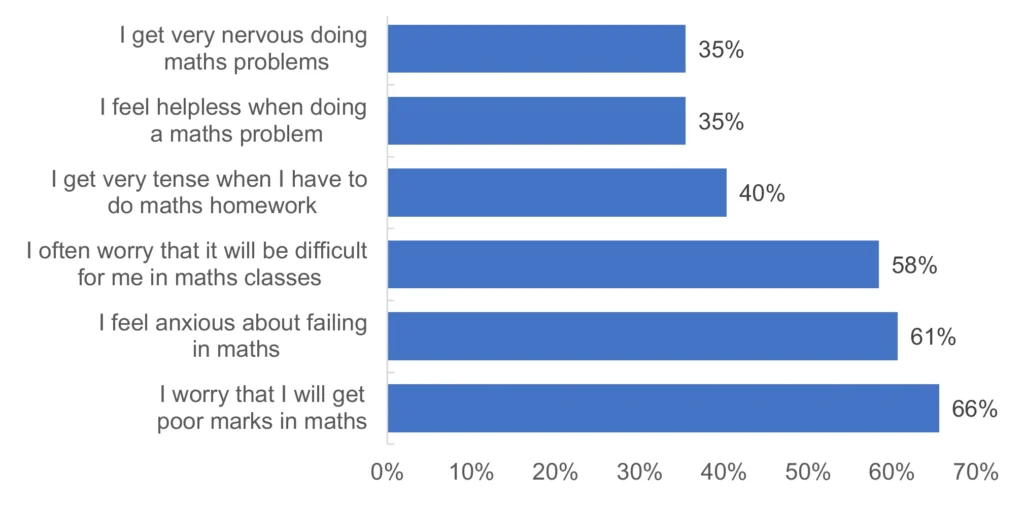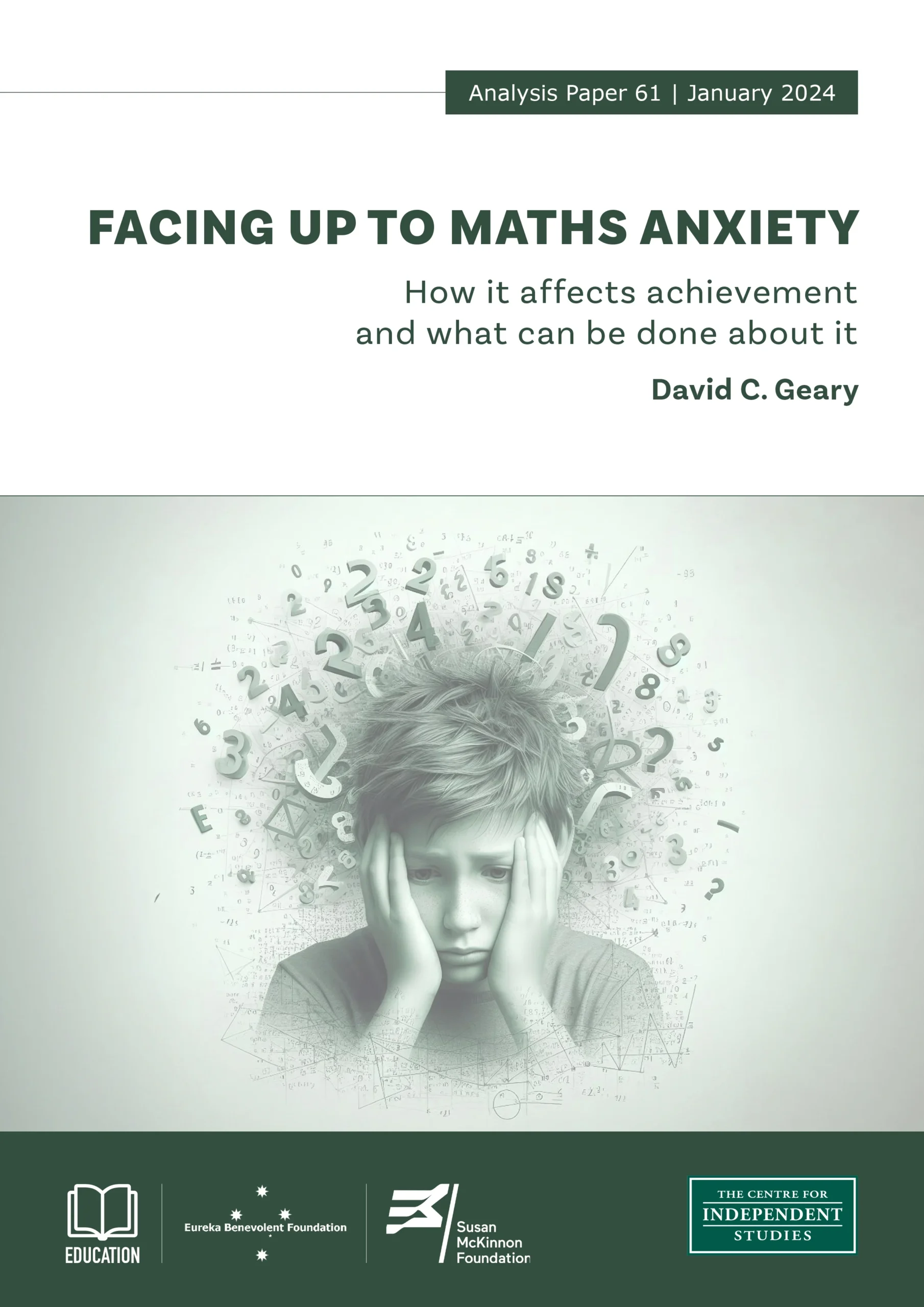
Executive summary
- The mathematical competencies of students have a long-term influence on their employability and wages in adulthood, and on their ability to navigate the many quantitative demands of day-to-day life in the modern world. These competencies are especially important for employment in many science, technology, engineering, and mathematics (STEM) fields.
- Mathematics anxiety is manifested as a fear or apprehension of mathematical activities and is one of many factors related to the development of mathematical competencies.
- Mathematics anxiety should be considered as an issue if it is persistently associated with lower-than-expected performance in mathematics based on standardised maths measures; avoidance of beneficial mathematics activities or coursework; or, high subjective feelings of discomfort during mathematics activities.
- According to the OECD’s Programme for International Student Assessment (PISA) study of 15-year-old students, a one-point increase in its Index of Mathematics Anxiety is associated with a decrease in mathematics achievement of 18 score points (close to the equivalent of one year’s worth of learning) after accounting for socio-economic backgrounds. Successive PISA studies have identified increasing levels of maths anxiety among students over recent decades.
- The cause-and-effect relations between mathematics achievement and mathematics anxiety are not fully understood, but generally difficulties (or perceived difficulties, independent of achievement) with mathematics precede the emergence of mathematics anxiety. In other words, students who experience early difficulties with maths are more likely to suffer from maths anxiety, rather than the other way around.
- Once formed, mathematics anxiety is associated with the avoidance (to the extent possible) of mathematical activities (e.g., reduced course taking) and, through this, compromised mathematical development. Mathematics anxiety can also disrupt performance during mathematical activities, potentially through concerns about performance that, in turn, reduces attentional resources from the mathematics learning or performance (e.g., test) episode.
- Four-to-five percent of students and adults report high levels of mathematics anxiety, although more modest levels can also interfere with maths performance. The 2017 Westpac Numeracy Study found maths anxiety affects as many as a third of adults and children in Australia.
- Girls and women have higher levels of mathematics anxiety, on average, than do boys and men, independent of mathematics achievement.
- Biologically, mathematics anxiety appears to be a conditioned or learned fear response. Individuals who are prone to anxiety are more likely to acquire mathematics anxiety than are their less-anxious peers. The sex difference in risk for anxiety-related issues is likely a contributing factor to the sex difference in mathematics anxiety, although anxiety-prone boys and men are also at risk.
- The presence of maths anxiety among Australian students has prompted educators and policymakers to make adjustments in how maths is taught in efforts to accommodate or alleviate maths anxiety. In some instances, this has resulted in calls to reduce the type and format of testing (such as relaxing the timed conditions of maths tests), reducing the emphasis on procedural understanding, and relaxing the apparent inflexibility of requiring ‘correct’ results to maths problems.
- There is no consensus on the most appropriate intervention for mathematics anxiety, but structured one-on-one tutoring with adults or peers that improves mathematical competencies is a promising approach, particularly in building fluency and procedural and conceptual competencies. Outside of educational interventions, cognitive behaviour therapy is effective in reducing mathematics anxiety.
Introduction
Academic competencies at the end of schooling influence employability, wages, and the ability to navigate the complexities of living in a developed economy.[1] Many factors influence individual differences in mathematical development, including attitudes (e.g., mathematics self-efficacy), cognitive abilities (e.g., executive functions, spatial abilities), home environment, instructional practices, and mathematics anxiety.[2] The latter manifests as apprehension or anxiety when having to engage with mathematics materials and especially mathematics tests.[3] Higher mathematics anxiety is associated with lower mathematics achievement and avoidance of mathematics coursework that, in turn, can compromise long-term educational opportunities, especially for fields that are heavily dependent on mathematical competencies.[4]
The relation between mathematics anxiety and occupational choices is especially pronounced for entry into science, technology, engineering, and mathematics (STEM) professions, and thus has implications for the pipeline for entry into these careers. As an example, one nationally (United States) representative study found that students who had consistently high or increasing mathematics anxiety from seventh grade through the end of secondary school were about 5 to 7 times less likely to be employed in STEM fields in their 30s relative to their low-anxiety peers, independent of sex, race, or ethnicity.[5] Other studies confirm that higher than average levels of mathematics anxiety are either directly or indirectly (acting through maths self-efficacy) related to lower levels of interest in STEM careers.[6] The implication is that increasing mathematical competencies and decreasing mathematics anxiety will increase the numbers of students who will aspire to, and eventually enter, critical STEM fields.
Although these relations are well established, there are multiple issues that remain to be fully understood. The first and second sections address the prevalence and cause-effect relation between mathematics achievement and mathematics anxiety, respectively, whereas the third focuses on sex differences in mathematics anxiety and the associated implications. The fourth section focuses on the biology of general anxiety, including risk of phobia development, as related to mathematics anxiety. Treatment research is summarised in the final section.
Prevalence
Performance on mathematics anxiety measures is continuous and thus there is no obvious cutoff for diagnosing it. In studies of US college students, Ashcraft and Moore indicated that students who are one standard deviation above the mean for mathematics anxiety (about 17% of students) show larger than expected (based on their math competence) performance decrements when solving complex arithmetic problems, although they note that 17% is not a prevalence estimate.[7] In a large-scale (n = 1000) study of adults in the general population, Hart and Ganley found that 5.4% of them reported substantive (> 4 on a l [low anxiety] to 5 [high anxiety] scale) levels of mathematics anxiety.[8] Using a similar criteria (often feeling anxious about mathematics) and across almost 2100 adolescents, Chinn found that about 4% of middle and secondary school (year 7 to 11, inclusive) students in the United Kingdom could be considered mathematically anxious.[9]
In another large-scale study, Devine and colleagues assessed the relation between mathematics anxiety and dyscalculia or mathematics learning difficulties (about 6% of the students) in 1757 8-to-13-year-olds.[10] The cutoff for high mathematics anxiety was the 90th percentile, that is, the 10 percent of students with the highest levels of mathematics anxiety. Using this cutoff, 22% of the students with maths difficulties had high mathematics anxiety, as compared to 10% of typically achieving students. Another way of looking at these results is that many students with maths difficulties do not experience excessive levels of mathematics anxiety and many students who are doing well in mathematics report high levels of mathematics anxiety.
In all, it appears that 4-5% of children and adults report relatively high levels of mathematics anxiety, although even more modest levels can sometimes disrupt mathematical performance. Unfortunately, there is no specific cutoff on self-report measures that can be used to diagnose mathematics anxiety, but Cipora and colleagues suggest a sensible set of criteria for such a diagnosis. They propose that anyone experiencing at least one of the three criteria below over an extended period of time be considered mathematics anxious:[11]
- The reported level of mathematics anxiety is associated with worse than expected mathematics performance on tests that are within their capabilities (e.g., based on math achievement scores), as found by Ashcraft and Moore.
- Mathematics anxiety is reported as a reason for avoiding mathematics activities or coursework that would be beneficial for long-term educational and occupational options.
- Reports of high levels of anxiety or subjective discomfort when engaging in mathematics activities. These might occur with strong mathematics competencies, but might still warrant intervention.
Although high levels of maths anxiety are identified among a relatively small proportion of the population, modest levels do appear to impact a substantial number. For instance, the 2017 Westpac Numeracy Study found maths anxiety affects as many as a third of adults and children in Australia. In the recently published PISA study, high numbers of Australian students reported some degree of anxiety or discomfort with mathematics (see graph below).
Proportion of Australian 15-year-old’s who agree with the following statements

Source: OECD (2023). Programme for International Student Assessment
Mathematics Anxiety and Mathematical Development
Higher mathematics anxiety is associated with lower performance on various mathematics measures, with correlations typically around -.30.[12] These relations are found for school-taught or biologically secondary maths competencies and not for the biologically primary or evolved intuitive sense of quantity.[13] However, the cause-effect, developmental relations between mathematics achievement and anxiety are uncertain, but research to date suggests that prior mathematics achievement is more strongly related to later anxiety than prior mathematics anxiety is to later achievement.
Gunderson and colleagues, for instance, found that higher achieving first and second graders had lower mathematics anxiety six months later (b = -.20, d = -.41), and students with lower mathematics anxiety had higher mathematics achievement six months later but with a smaller effect (b = -.06, d = -.12).[14] These relations held for girls and boys. Several longitudinal studies assessing the transition to secondary school confirmed that achievement is more strongly related to later anxiety than the reverse.[15] Wang and colleagues found the same for secondary school students, that is, mathematics grades predicted later mathematics anxiety, but anxiety did not predict later grades.[16]
In sum, mathematics achievement is generally a stronger predictor of later anxiety than anxiety is of later achievement, but this does not mean that mathematics anxiety does not influence later engagement with mathematics. This is because once it emerges, mathematics anxiety can result in avoidance of mathematics fields and disrupt performance during mathematics activities, especially during mathematics tests. As noted, high levels of mathematics anxiety during schooling is associated with much lower odds of entering a STEM field, and consistent with this finding, a lower interest in STEM fields while in school, and perhaps more so for girls than boys.[17] Choe and colleagues showed that high mathematics anxiety is associated with avoidance of more difficult mathematics tasks, even when those tasks had a monetary payoff, and with control of mathematical performance. They argued that “individuals with maths anxiety avoid the high-reward, high-effort maths options because they perceive the costs of effortful maths engagement to outweigh its benefits”[18]. The costs might be related to the biological reactions, such as fear and pain, associated with the anticipation of engaging with mathematics, as elaborated below.
Stated differently, struggles or perceived struggles (i.e., students who are doing fine in mathematics but perceive themselves as struggling) with mathematics increases the risk of developing mathematics anxiety. Once developed, mathematics anxiety further undermines mathematics performance and long-term development.
Note, however, that there are many students who struggle with mathematics who do not have elevated levels of mathematics anxiety, although they typically have lower than average mathematics self-efficacy, that is, low beliefs about their ability to succeed in mathematical endeavours.[19] Indeed, Scofield and colleagues’ analysis of almost 2000 adolescents suggested that mathematics self-efficacy is more strongly influenced by maths performance than is mathematics anxiety, leaving room for a disconnection between anxiety and performance.[20]
As noted, Devine and colleagues found that close to four out of five 8-to-13-year-old students with dyscalculia or mathematics learning difficulties (about 6% of the students) had mathematics anxiety scores lower than expected based on their math performance.[21] These are students who have likely disengaged from mathematics and thus their performance is not a personal concern for them.
At the same time, about 10% of students who are doing average or better in mathematics report high levels of mathematics anxiety. In other words, most children with maths difficulties do not have high mathematics anxiety, and three out of four students with high mathematics anxiety are typically or high achieving in mathematics.
Sex Differences in Mathematics Anxiety and Mathematics Achievement
The magnitude, sources, and significance of sex differences in mathematics achievement have been studied and debated for decades.[22] At the mean, sex differences are typically small and can vary from one topic or one nation to the next.[23] In a multi-year and multi-national study that included about 1.5 million adolescents, Stoet and Geary found a small overall advantage for boys (d = .10, that is, .10 standard deviations) that was found in most but not all nations. An effect of this size means that 55% of adolescent boys score higher than the average girl (i.e., above the 50th percentile for girls).[24] At the same time, there are consistent differences, favouring boys and men, at the high end of performance and in certain mathematical domains, as well as areas in which girls and women typically have advantages.[25] When these differences are found, they are typically related to some combination of sex differences in spatial abilities (favouring boys and men), in-class attentive behaviour (favouring girls and women), and mathematics anxiety.[26]
As mentioned, higher mathematics anxiety is associated with lower mathematics achievement and avoidance of mathematics coursework.[27] This is found for boys and girls as well as men and women, but the long-term consequences might be more severe for girls and women because they experience higher levels of mathematics anxiety, even when controlling for overall mathematics achievement.[28] Stoet and colleagues’ large-scale study of adolescents across 68 countries (n = 761,655) revealed moderately higher sex differences in mathematics anxiety (d = .23 to .28) in most countries (in 95% of countries in one assessment and in 82% in another). Critically, girls’ higher mathematics anxiety was found even when controlling for overall mathematics achievement (d = .21 to .25); effects of these sizes mean that about 60% of adolescent girls have higher mathematics anxiety than the average boy, independent of mathematics performance.[29]
One possibility is that the sex difference in excess (beyond achievement levels) mathematics anxiety is simply a reflection of the sex difference in test anxiety.[30] However, Devine and colleagues found that higher mathematics anxiety was associated with lower mathematics performance for girls and boys, but this relation disappeared with control of test anxiety but only for boys.[31] In other words, girls appear to have higher levels of mathematics anxiety, even with control of mathematics achievement and test anxiety. A more recent study found the same, that is, that adolescent girls had higher mathematics anxiety than their male peers, even with control of trait anxiety.[32]
Related studies have shown the sex difference in spatial abilities might also contribute to girls’ higher mathematics anxiety, mediated in part by spatial anxiety.[33] In other words, spatial abilities influence performance and learning in some areas of mathematics, and these are areas that are more difficult for girls than boys. They are also difficult for boys with relatively lower spatial abilities, but there are more girls than boys that find solving spatial-related mathematics problems difficult, which likely contributes to both spatial and mathematics anxiety.[34]
Whatever is contributing to the sex differences in mathematics anxiety, studies by Devine and colleagues and Geary and colleagues suggested that the magnitude of the relation between mathematics anxiety and mathematics outcomes might be larger for girls than boys when assessed in the same grade.[35] Caviola and colleagues’ meta-analysis also revealed a stronger correlation between mathematics anxiety and achievement for girls (r = -.29) than boys (r = -.20), but the difference was only a trend (p = .075).[36] They note that most studies in their meta-analysis did not explore the relation between mathematics achievement and mathematics anxiety independently for girls and boys, and so the issue of whether the relation is stronger in girls than boys remains unsettled.
A more recent three-year longitudinal study added some nuance to these patterns.[37] The basic finding was that as students moved into secondary school, attitudes about mathematics declined (for boys and girls) and mathematics anxiety increased (again for boys and girls). Boys who showed strong gains in mathematics across these years had relatively better attitudes and relatively lower mathematics anxiety than their peers, but this was not the case for girls who showed strong gains in mathematics. Their mathematics attitudes declined, and anxiety increased just as much as their peers who were not doing as well in mathematics.
The reason for this pattern is not clear, but correlations between mathematics achievement and mathematics self-efficacy and utility beliefs provided some clues. Mathematics self-efficacy represents self-appraisals about one’s math competencies and utility beliefs about the long-term usefulness of mathematics. These two core attitudes predict enrolment in mathematics courses in high school and college.[38] For girls and boys, the relation between mathematics achievement and mathematics self-efficacy was positive and similar in magnitude, but these relations diverged for utility beliefs. For boys, gains in mathematics achievement were associated with gains in next-grade utility beliefs, but this was not the case for girls. These patterns, combined with similar findings from another study, suggest that boys’ mathematics achievement is directly influencing their evaluations about the long-term usefulness of mathematics as potentially related to job aspirations.[39] The focus of higher achieving boys on the future usefulness of mathematics may have protected them from the developmental increase in mathematics anxiety found in other students, including higher-achieving girls.
Biological Foundations and General Anxiety
As noted, mathematics anxiety manifests as apprehension or anxiety when having to engage with mathematics and especially mathematics tests. The finding that student struggles with mathematics generally precede the development of mathematics anxiety combined with the need to continually engage with it during schooling suggests that it is a learned fear. Indeed, mathematics is an evolutionarily novel, biologically secondary academic domain and thus an inherent math-specific anxiety is unlikely.[40]
In this view, mathematics anxiety emerges through fear conditioning, whereby anxiety-prone individuals are more likely to acquire it than their less-anxious peers if they experience anxiety during mathematics learning or evaluations — or if anxiety about mathematics is conveyed by important adults in their life, such as their parents or teachers.[41] Indeed, individuals with high levels of mathematics anxiety have physiological and other responses like those found with phobias, and the genetic risks associated with general anxiety contribute to mathematics anxiety, independent of maths competencies.[42]
These patterns are consistent with Young and colleagues’ finding that mathematics anxiety is correlated with engagement of an amygdala nucleus (associated with emotion processing) that contributes to fear conditioning (i.e., reacting with anxiety to cues of potential threats).[43] In these situations, the anxiety provoking situation engages the amygdala and attentional brain networks (especially the salience network) that in turn result in an exaggerated focus on and response to the potential threat, as well as a feeling of pain in anticipation of the threat.[44] This shift in focus (e.g., ruminating on potentially failing) disrupts attentional focus and working memory resources that in turn can interfere with performance on mathematics tests or during mathematics learning.[45] A related study found that individuals with higher levels of mathematics anxiety showed less deactivation of the brain network (i.e., default mode network) associated with self-relevant ruminating (among other things) than their peers while engaged in number processing. The poor deactivation of this brain network is in keeping with a preoccupation with performing poorly during mathematics activities and this in turn will interfere with mathematics learning and performance.[46]
The sex difference in mathematics anxiety is likely related to the sex difference in these mechanisms, that is, proneness to develop phobias and anxiety related disorders.[47] At the same time, boys with higher-than-average levels of general anxiety are just as prone to developing mathematics anxiety as are girls with similar levels of general anxiety. In other words, the sex difference in mathematics anxiety is not directly due to being male or female, but rather due to an underling proneness to develop excess anxiety reactions in stressful contexts.
Treatment
Many people cope with acquired fears, including mathematics anxiety, by avoiding the situations associated with the fear or anxiety, and this avoidance perpetuates it.[48] Avoidance of mathematics will reduce long-term educational and occupational options, and thus reductions in anxiety could be beneficial for many students. The field is in the early stages of developing interventions for mathematics anxiety, but there are some promising approaches.
A common approach to the general treatment of fears and phobias is to increase exposure to the threat, which over time can result in a decline in the associated fear or anxiety. For mathematics this would involve improving basic mathematics competencies, starting at a level that would ensure success, which has been found to simultaneously reduce mathematics anxiety and reduce the over-reactivity of the amygdala.[49]
In this study, primary school children who were highly maths anxious and their low-anxious peers participated in an eight week (three 45-minute sessions/week) one-on-one tutoring session focused on basic arithmetic. Participants were given a brain imaging assessment before and after tutoring. The math-anxious students showed significant reductions in mathematics anxiety and both groups experienced improved basic arithmetic skills. The brain imaging component revealed that the amygdala and other neural responses of the math-anxious students were typical (i.e., same as low-anxious students) after tutoring, indicating that the reported reduction in maths anxiety was associated with changes in amygdala reactivity to mathematics material.
In an experimental study, Moliner and Alegre randomly assigned students to reciprocal peer tutoring (the students take turns being the tutor and tutee) or a business-as-usual control group. The peer tutoring group continued with standard classroom instruction and participated in three 20-minute tutoring sessions a week for six months. The students in the tutoring group showed significantly reduced mathematics anxiety associated with learning and with evaluations, but there were no changes in the control group.[50]
These were highly organised and structured interventions focused on improving basic mathematics competencies and not more child-directed approaches. The latter in fact may exacerbate the problem because of the tendency for highly anxious individuals to avoid the source of the anxiety, mathematics in this case. A less organised instructional approach might provide maths anxious students more opportunities to avoid mathematics material and thus fall further behind their peers. As with other students who struggle with mathematics, building fluency and procedural and conceptual competencies through an organised, direct instruction approach is likely to be more effective than less organised approaches.[51]
Other components of such interventions might involve changing how students appraise their difficulties with mathematics — specifically, instilling a realisation that occasional struggles are due to the difficulty of learning the material and not due to lack of ability to improve one’s mathematical competencies.[52] There are also brief interventions to help students cope with mathematics and related (e.g., test) anxieties. These including, for instance, instructing students to reappraise their anxiety as excitement, or to first write about their anxiety, but their usefulness in reducing anxiety has not been consistently demonstrated.[53]
Outside of classroom settings, cognitive behavioural therapy (CBT) is a more general and common approach to treating anxiety disorders and phobias and is typically effective for most people.[54] Hofman and colleagues’ meta-analysis indicated that CBT is effective in reducing anxiety and suggested that about 3 out of 4 people receiving this treatment showed significant reductions in anxiety as well as broader improvements in their reported quality of life.[55] It follows that CBT should also be helpful for treating mathematics anxiety.[56] Hembree’s early meta-analysis confirmed that CBT can be effective in reducing mathematics anxiety and is associated with later gains in mathematics performance.[57]
Conclusions and Implications
Mathematics anxiety is experienced as an apprehension about or fear of engaging in mathematics learning and especially mathematics assessment. Brain imaging studies indicate that high levels of mathematics anxiety are associated with strong reactivity of the brain network that underlies acquired or learned fears and thus student reports of mathematics anxiety should be considered realistic appraisals of their apprehension of mathematics. In other words, the engagement of brain regions associated with fear and anxiety reactions and ruminations about them indicate that mathematics anxiety is a real phenomenon rooted in biological systems that evolved to reduce exposure to potential threats.
Mathematics anxiety appears to develop from struggles with learning mathematics, although not all students who struggle develop anxiety. For those who do develop anxiety, the long-term effect is often avoidance of mathematics coursework and oftentimes difficulties focusing when engaged with mathematics.
Students who are generally anxious, which includes more girls than boys, are at higher risk of developing mathematics anxiety than their calmer peers. The sex difference emerges because of the difference in average levels of anxiety and risk for forming acquired fears, not because they are girls per se. In other words, boys with high levels of general anxiety are just as likely to develop mathematics anxiety as are girls with comparable levels of general anxiety.
There is no current consensus on the most appropriate intervention for mathematics anxiety, but one-on-one tutoring with adults or peers that improves mathematics competencies is a promising approach. These educational approaches are likely to work best if they are organised and structured in a step-by-step manner. This is because highly anxious individuals tend to avoid engaging with the anxiety-provoking material and thus more student-directed learning approaches are likely to provide more opportunities to skip over or avoid more difficult mathematics. Outside of educational interventions, cognitive behaviour therapy can significantly reduce mathematics anxiety.
Endnotes
[1] Richmond-Rakerd, L. S., D’Souza, S., Andersen, S. H., Hogan, S., Houts, R. M., Poulton, R., & Moffitt, T. E. (2020). Clustering of health, crime and social-welfare inequality in 4 million citizens from two nations. Nature Human Behaviour, 4, 255-264. https://doi.org/10.1038/s41562-019-0810-4; Ritchie, S. J., & Bates, T. C. (2013). Enduring links from childhood mathematics and reading achievement to adult socioeconomic status. Psychological Science, 24, 1301–1308. https://doi.org/10.1177/0956797612466268
[2] Ashcraft, M. H. (2002). Math anxiety: Personal, educational, and cognitive consequences.
Current Directions in Psychological Science, 11(5), 181-185. https://doi.org/10.1111/1467-8721.00196; Caviola, S., Toffalini, E., Giofrè, D., Ruiz, J. M., Szűcs, D., & Mammarella, I. C. (2022). Math performance and academic anxiety forms, from sociodemographic to cognitive aspects: A meta-analysis on 906,311 participants. Educational Psychology Review, 34(1), 363-399. https://doi.org/10.1007/s10648-021-09618-5; Eccles, J. S., & Wigfield, A. (2002). Motivational beliefs, values, and goals. Annual Review of Psychology, 53, 109-132. https://doi:10.1146/annurev.psych.53.100901.135153; Geary, D. C., Hoard, M. K., & Nugent, L., & Ünal, Z. E. (2023). Sex differences in developmental pathways to mathematical competence. Journal of Educational Psychology, 115, 212–228. https://doi.org/10.1037/edu0000763; Levine, S. C., & Pantoja, N. (2021). Development of children’s math attitudes: Gender differences, key socializers, and intervention approaches. Developmental Review, 60, 100997. https://doi.org/10.1016/j.dr.2021.100997; Sweller, J., & Cooper, G. A. (1985). The use of worked examples as a substitute for problem solving in learning algebra. Cognition and instruction, 2(1), 59-89. https://doi.org/10.1207/s1532690xci0201_3; Zippert, E. L., & Rittle-Johnson, B. (2020). The home math environment: More than numeracy. Early Childhood Research Quarterly, 50(3), 4-15. https://doi.org/10.1016/j.ecresq.2018.07.009
[3] Ashcraft, M. H. (2002). Math anxiety: Personal, educational, and cognitive consequences.
Current Directions in Psychological Science, 11(5), 181-185. https://doi.org/10.1111/1467-8721.00196; Baloglu, M., & Koçak, R. (2006). A multivariate investigation of the differences in mathematics anxiety. Personality and Individual Differences, 40, 1325–1335. https://doi:10.1016/j.paid.2005.10.009; Hembree, R. (1990). The nature, effects, and relief of mathematics anxiety. Journal for Research in Mathematics Education, 21, 33-46. https://doi:10.2307/749455
[4] Caviola, S., Toffalini, E., Giofrè, D., Ruiz, J. M., Szűcs, D., & Mammarella, I. C. (2022). Math performance and academic anxiety forms, from sociodemographic to cognitive aspects: A meta-analysis on 906,311 participants. Educational Psychology Review, 34(1), 363-399.
https://doi.org/10.1007/s10648-021-09618-5; Dowker, A., Sarkar, A., & Looi, C. Y. (2016). Mathematics anxiety: What have we learned in 60 years? Frontiers in Psychology, 7, 508. https://doi:10.3389/fpsyg.2016.00508; Ma, X. (1999). A meta-analysis of the relationship between anxiety toward mathematics and achievement in mathematics. Journal for Research in Mathematics Education, 30, 520-540. https://doi:10.2307/749772
[5] Ahmed, W. (2018). Developmental trajectories of math anxiety during adolescence: Associations with STEM career choice. Journal of Adolescence, 67, 158-166. https://doi.org/10.1016/j.adolescence.2018.06.010
[6] Cribbs, J., Huang, X., & Piatek‐Jimenez, K. (2021). Relations of mathematics mindset, mathematics anxiety, mathematics identity, and mathematics self‐efficacy to STEM career choice: A structural equation modeling approach. School Science and Mathematics, 121(5), 275-287. https://doi.org/10.1111/ssm.12470Huang, X., Zhang, J., & Hudson, L. (2019). Impact of math self-efficacy, math anxiety, and growth mindset on math and science career interest for middle school students: The gender moderating effect. European Journal of Psychology of Education, 34, 621-640. https://doi.org/10.1007/s10212-018-0403-z
[7] Ashcraft, M. H., & Moore, A. M. (2009). Mathematics anxiety and the affective drop in performance. Journal of Psychoeducational Assessment, 27(3), 197-205. https://doi.org/10.1177/0734282908330580
[8] Hart, S. A., & Ganley, C. M. (2019). The nature of math anxiety in adults: Prevalence and correlates. Journal of Numerical Cognition, 5(2), 122-139. https://doi.org/10.5964/jnc.v5i2.195
[9] Chinn, S. (2009). Mathematics anxiety in secondary students in England. Dyslexia, 15(1), 61-68. https://doi.org/10.1002/dys.381
[10] Devine, A., Hill, F., Carey, E., & Szűcs, D. (2017). Cognitive and emotional math problems largely dissociate: Prevalence of developmental dyscalculia and mathematics anxiety. Journal of Educational Psychology, 110(3), 431–444. doi:10.1037/edu0000222; Scofield, J. E., Hoard, M. K., Nugent, L., LaMendola, J. V, & Geary, D. C. (2021). Mathematics clusters reveal strengths and weaknesses in adolescents’ mathematical competencies, spatial abilities, and mathematics attitudes. Journal of Cognition and Development, 22, 695-720. https://doi.org/10.1080/15248372.2021.1939351
[11] Cipora, K., Santos, F. H., Kucian, K., & Dowker, A. (2022). Mathematics anxiety—Where are we and where shall we go? Annals of the New York Academy of Sciences, 1513(1), 10-20. https://doi.org/10.1111/nyas.14770
[12] Hembree, R. (1990). The nature, effects, and relief of mathematics anxiety. Journal for Research in Mathematics Education, 21, 33-46. https://doi:10.2307/749455
[13] Geary, D. C. (in press). The evolved mind and modern education: Status of evolutionary educational psychology. Cambridge, UK: Cambridge University Press; Starling‐Alves, I., Wronski, M. R., & Hubbard, E. M. (2022). Math anxiety differentially impairs symbolic, but not nonsymbolic, fraction skills across development. Annals of the New York Academy of Sciences, 1509(1), 113-129. https://doi.org/10.1111/nyas.14715
[14] Gunderson, E. A., Park, D., Maloney, E. A., Beilock, S. L., & Levine, S. C. (2018). Reciprocal
relations among motivational frameworks, math anxiety, and math achievement in early elementary school. Journal of Cognition and Development, 19, 21-46. doi.org/10.1080/15248372.2017.1421538
[15] Geary, D. C., Hoard, M. K., & Nugent, L., Ünal, Z. E., & Greene, N. R. (2023). Sex differences and similarities in relations between mathematics achievement, attitudes, and anxiety: A 7th-to-9th grade longitudinal study. Journal of Educational Psychology, 115, 767-782. https://doi.org/10.1037/edu0000793; Ma, X., & Xu, J. (2004). The causal ordering of mathematics anxiety and mathematics achievement: a longitudinal panel analysis. Journal of Adolescence, 27(2), 165-179. https://doi.org/10.1016/j.adolescence.2003.11.003
[16] Wang, Z., Rimfeld, K., Shakeshaft, N., Schofield, K., & Malanchini, M. (2020). The longitudinal role of mathematics anxiety in mathematics development: Issues of gender differences and domain-specificity. Journal of Adolescence, 80, 220-232. https://doi.org/10.1016/j.adolescence.2020.03.003
[17] Huang, X., Zhang, J., & Hudson, L. (2019). Impact of math self-efficacy, math anxiety, and growth mindset on math and science career interest for middle school students: The gender moderating effect. European Journal of Psychology of Education, 34, 621-640. https://doi.org/10.1007/s10212-018-0403-z; Levy, H. E., Fares, L., & Rubinsten, O. (2021). Math anxiety affects females’ vocational interests. Journal of Experimental Child Psychology, 210, 105214. https://doi.org/10.1016/j.jecp.2021.105214
[18] P. 5, Choe, K. W., Jenifer, J. B., Rozek, C. S., Berman, M. G., & Beilock, S. L. (2019). Calculated avoidance: Math anxiety predicts math avoidance in effort-based decision-making. Science Advances, 5(11), eaay1062. https://doi.org/10.1126/sciadv.aay1062
[19] Eccles, J. S., & Wang, M. T. (2016). What motivates females and males to pursue careers in mathematics and science? International Journal of Behavioral Development, 40, 100-106. https://doi.org/10.1177/0165025415616201; Scofield, J. E., Hoard, M. K., Nugent, L., LaMendola, J. V, & Geary, D. C. (2021). Mathematics clusters reveal strengths and weaknesses in adolescents’ mathematical competencies, spatial abilities, and mathematics attitudes. Journal of Cognition and Development, 22, 695-720. https://doi.org/10.1080/15248372.2021.1939351
[20] Scofield, J. E., Hoard, M. K., Nugent, L., LaMendola, J. V, & Geary, D. C. (2021). Mathematics clusters reveal strengths and weaknesses in adolescents’ mathematical competencies, spatial abilities, and mathematics attitudes. Journal of Cognition and Development, 22, 695-720. https://doi.org/10.1080/15248372.2021.1939351
[21] Devine, A., Hill, F., Carey, E., & Szűcs, D. (2017). Cognitive and emotional math problems largely dissociate: Prevalence of developmental dyscalculia and mathematics anxiety. Journal of Educational Psychology, 110(3), 431–444. doi:10.1037/edu0000222; Scofield, J. E., Hoard, M. K., Nugent, L., LaMendola, J. V, & Geary, D. C. (2021). Mathematics clusters reveal strengths and weaknesses in adolescents’ mathematical competencies, spatial abilities, and mathematics attitudes. Journal of Cognition and Development, 22, 695-720. https://doi.org/10.1080/15248372.2021.1939351
[22] Ceci, S. J., & Williams, W. M. (2010). The mathematics of sex: How biology and society conspire to limit talented women and girls. New York: Oxford University Press.; Geary, D. C. (1996). Sexual selection and sex differences in mathematical abilities. Behavioral and Brain Sciences, 19, 229-284. doi:10.1017/S0140525X00042400; Halpern, D., Benbow, C., Geary, D. C., Gur, R., Hyde, J., & Gernsbacher, M. A. (2007). The science of sex differences in science and mathematics. Psychological Science in the Public Interest, 8 (No 1, 1-52). doi:10.1111/j.1529-1006.2007.00032.x
[23] Hyde, J. S., Fennema, E., & Lamon, S. (1990). Gender differences in mathematics performance: A meta-analysis. Psychological Bulletin, 107, 139–155. doi:10.1037/0033-2909.107.2.139
[24] Stoet, G., & Geary, D. C. (2013). Sex differences in mathematics and reading achievement are inversely related: Within- and across-nation assessment of 10 years of PISA data. PLoS ONE, 8(3): e57988. https://doi.org/10.1371/journal.pone.0057988
[25] Gallagher, A. M., & De Lisi, R. (1994). Gender differences in Scholastic Aptitude Test: Mathematics problem solving among high-ability students. Journal of Educational Psychology, 86, 204–211. https://doi.org/10.1037/0022-0663.86.2.204;; Hyde, J. S., Fennema, E., & Lamon, S. (1990). Gender differences in mathematics performance: A meta-analysis. Psychological Bulletin, 107, 139–155. doi:10.1037/0033-2909.107.2.139; Wai, J., Hodges, J., & Makel, M. C. (2018). Sex differences in ability tilt in the right tail of cognitive abilities: A 35-year examination. Intelligence, 67, 76-83. doi:10.1016/j.intell.2018.02.003
[26] Geary, D. C., Hoard, M. K., Nugent, L., & Scofield, J. E. (2021). In-class attentive behaviour, spatial ability, and mathematics anxiety predict across-grade gains in adolescents’ mathematics achievement. Journal of Educational Psychology, 113, 754-769; Geary, D. C., Hoard, M. K., & Nugent, L., & Ünal, Z. E. (2023). Sex differences in developmental pathways to mathematical competence. Journal of Educational Psychology, 115, 212–228.
[27] Caviola, S., Toffalini, E., Giofrè, D., Ruiz, J. M., Szűcs, D., & Mammarella, I. C. (2022). Math performance and academic anxiety forms, from sociodemographic to cognitive aspects: A meta-analysis on 906,311 participants. Educational Psychology Review, 34(1), 363-399. https://doi.org/10.1007/s10648-021-09618-5; Dowker, A., Sarkar, A., & Looi, C. Y. (2016). Mathematics anxiety: What have we learned in 60 years? Frontiers in Psychology, 7, 508. https://doi:10.3389/fpsyg.2016.00508; Hembree, R. (1990). The nature, effects, and relief of mathematics anxiety. Journal for Research in Mathematics Education, 21, 33-46. https://doi:10.2307/749455; Ma, X. (1999). A meta-analysis of the relationship between anxiety toward mathematics and achievement in mathematics. Journal for Research in Mathematics Education, 30, 520-540. doi:10.2307/749772; Meece, J. L., Wigfield, A., & Eccles, J. S. (1990). Predictors of math anxiety and its influence on young adolescents’ course enrolment intentions and performance in mathematics. Journal of Educational Psychology, 82, 60-70. doi:10.1037/0022-0663.82.1.60
[28] Hyde, J. S., Fennema, E., Ryan, M., Frost, L. A., & Hopp, C. (1990). Gender comparisons of mathematics attitudes and affect. Psychology of Women Quarterly, 14, 299-324. doi:10.1111/j.1471-6402.1990.tb00022.x
[29] Stoet, G., Bailey, D. H., Moore, A. M., & Geary, D. C. (2016). Countries with higher levels of gender equality show larger national sex differences in mathematics anxiety and relatively lower parental mathematics valuation for girls. PloS ONE, 11(4): e0153857. https://doi.org/10.1371/journal.pone.0153857
[30] Caviola, S., Toffalini, E., Giofrè, D., Ruiz, J. M., Szűcs, D., & Mammarella, I. C. (2022). Math performance and academic anxiety forms, from sociodemographic to cognitive aspects: A meta-analysis on 906,311 participants. Educational Psychology Review, 34(1), 363-399. https://doi.org/10.1007/s10648-021-09618-5
[31] Devine, A., Fawcett, K., Szűcs, D., & Dowker, A. (2012). Gender differences in mathematics anxiety and the relation to mathematics performance while controlling for test anxiety. Behavioral and Brain Functions, 8, 33. https://doi:10.1186/1744-9081-8-33
[32] Geary, D. C., Hoard, M. K., & Nugent, L., Ünal, Z. E., & Greene, N. R. (2023). Sex differences and similarities in relations between mathematics achievement, attitudes, and anxiety: A 7th-to-9th grade longitudinal study. Journal of Educational Psychology, 115, 767-782. https://doi.org/10.1037/edu0000793
[33] Ferguson, A. M., Maloney, E. A., Fugelsang, J., & Risko, E. F. (2015). On the relation between math and spatial ability: The case of math anxiety. Learning and Individual Differences, 39, 1-12. https://doi.org/10.1016/j.lindif.2015.02.007; Maloney, E. A., Waechter, S., Risko, E. F., & Fugelsang, J. A. (2012). Reducing the sex difference in math anxiety: The role of spatial processing ability. Learning and Individual Differences, 22(3), 380-384.https://doi.org/10.1016/j.lindif.2012.01.001
[34] Geary, D. C., Hoard, M. K., & Nugent, L., Ünal, Z. E., & Greene, N. R. (2023). Sex differences and similarities in relations between mathematics achievement, attitudes, and anxiety: A 7th-to-9th grade longitudinal study. Journal of Educational Psychology, 115, 767-782. https://doi.org/10.1037/edu0000793
[35] Devine, A., Fawcett, K., Szűcs, D., & Dowker, A. (2012). Gender differences in mathematics
anxiety and the relation to mathematics performance while controlling for test anxiety. Behavioral and Brain Functions, 8, 33. https://doi:10.1186/1744-9081-8-33; Geary, D. C., Hoard, M. K., Nugent, L., Chu, F. W., Scofield, J. E., & Hibbard, D. F. (2019). Sex
differences in mathematics anxiety and attitudes: Concurrent and longitudinal relations to mathematical competence. Journal of Educational Psychology, 111, 1447–1461. https://doi.org/10.1037/edu0000355
[36] Caviola, S., Toffalini, E., Giofrè, D., Ruiz, J. M., Szűcs, D., & Mammarella, I. C. (2022). Math performance and academic anxiety forms, from sociodemographic to cognitive aspects: A meta-analysis on 906,311 participants. Educational Psychology Review, 34(1), 363-399. https://doi.org/10.1007/s10648-021-09618-5
[37] Geary, D. C., Hoard, M. K., & Nugent, L., Ünal, Z. E., & Greene, N. R. (2023). Sex differences and similarities in relations between mathematics achievement, attitudes, and anxiety: A 7th-to-9th grade longitudinal study. Journal of Educational Psychology, 115, 767-782. https://doi.org/10.1037/edu0000793
[38] Crombie, G., Sinclair, N., Silverthorn, N., Byrne, B. M., DuBois, D. L., & Trinneer, A. (2005). Predictors of young adolescents’ math grades and course enrollment intentions: Gender similarities and differences. Sex Roles, 52, 351-367. https://doi:10.1007/s11199-005-2678-1; Eccles, J. S., & Wang, M. T. (2016). What motivates females and males to pursue careers in mathematics and science? International Journal of Behavioral Development, 40, 100-106. https://doi.org/10.1177/0165025415616201
[39] Gaspard, H., Dicke, A. L., Flunger, B., Schreier, B., Häfner, I., Trautwein, U., & Nagengast, B. (2015). More value through greater differentiation: Gender differences in value beliefs about math. Journal of Educational Psychology, 107, 663-677. https://doi:10.1037/edu0000003
[40]Geary, D. C. (1995). Reflections of evolution and culture in children’s cognition: Implications for mathematical development and instruction. American Psychologist, 50, 24-37. https://doi:10.1037/0003-066X.50.1.24; Geary, D. C. (in press) The evolved mind and modern education: Status of evolutionary educational psychology. Cambridge, UK: Cambridge University Press.
[41] Levine, S. C., & Pantoja, N. (2021). Development of children’s math attitudes: Gender differences, key socializers, and intervention approaches. Developmental Review, 60, 100997. https://doi.org/10.1016/j.dr.2021.100997
[42] Hembree, R. (1990). The nature, effects, and relief of mathematics anxiety. Journal for Research in Mathematics Education, 21, 33-46. https://doi:10.2307/749455; Lyons, I. M., & Beilock, S. L. (2012). When math hurts: math anxiety predicts pain network activation in anticipation of doing math. PLoS ONE, 7(10), e48076. doi:10.1371/journal.pone.0048076; Wang, Z., Hart, S. A., Kovas, Y., Lukowski, S., Soden, B., Thompson, L. A., … & Petrill, S. A. (2014). Who is afraid of math? Two sources of genetic variance for mathematical anxiety. Journal of Child Psychology and Psychiatry, 55(9), 1056-1064. https://doi.org/10.1111/jcpp.12224
[43] Young, C. B., Wu, S. S., & Menon, V. (2012). The neurodevelopmental basis of math anxiety. Psychological Science, 23, 492-501. https://doi:10.1177/0956797611429134
[44] Lyons, I. M., & Beilock, S. L. (2012). When math hurts: math anxiety predicts pain network activation in anticipation of doing math. PloS one, 7(10), e48076. https://doi.org/10.1371/journal.pone.0048076
[45] Ashcraft, M. H., & Krause, J. A. (2007). Working memory, math performance, and math anxiety. Psychonomic Bulletin & Review, 14(2), 243-248. https://doi.org/10.3758/BF03194059; Ramirez, G., Shaw, S. T., & Maloney, E. A. (2018). Math anxiety: Past research, promising interventions, and a new interpretation framework. Educational Psychologist, 53(3), 145-164. https://doi.org/10.1080/00461520.2018.1447384
[46] Pletzer, B., Kronbichler, M., Nuerk, H. C., & Kerschbaum, H. H. (2015). Mathematics anxiety reduces default mode network deactivation in response to numerical tasks. Frontiers in Human Neuroscience, 9, 202. https://doi.org/10.3389/fnhum.2015.00202
[47] Bandelow, B., & Michaelis, S. (2015). Epidemiology of anxiety disorders in the 21st century. Dialogues in Clinical Neuroscience, 17, 327-335. https://doi.org/10.31887/DCNS.2015.17.3/bbandelow
[48] Daker, R. J., Gattas, S. U., Sokolowski, H. M., Green, A. E., & Lyons, I. M. (2021). First-year students’ math anxiety predicts STEM avoidance and underperformance throughout university, independently of math ability. npj Science of Learning, 6(1), 17. https://doi.org/10.1038/s41539-021-00095-7; Dowker, A., Sarkar, A., & Looi, C. Y. (2016). Mathematics anxiety: What have we learned in 60 years? Frontiers in Psychology, 7, 508. https://doi:10.3389/fpsyg.2016.00508; McNally, R. J. (1987). Preparedness and phobias: a review. Psychological Bulletin, 101(2), 283-303. https://doi.org/10.1037/0033-2909.101.2.283
[49] Supekar, K., Iuculano, T., Chen, L., & Menon, V. (2015). Remediation of childhood math anxiety and associated neural circuits through cognitive tutoring. Journal of Neuroscience, 35(36), 12574-12583. https://doi.org/10.1523/JNEUROSCI.0786-15.2015
[50] Moliner, L., & Alegre, F. (2020). Peer tutoring effects on students’ mathematics anxiety: A middle school experience. Frontiers in psychology, 11, 1610. https://doi.org/10.3389/fpsyg.2020.01610
[51] Hatten-Roberts, T. (2023). The need for speed: Why fluency counts for math learning (Analysis paper 57). Sydney, Australia: The Centre for Independent Studies; National Mathematics Advisory Panel. (2008). Foundations for Success: Final Report of the National Mathematics Advisory Panel. Washington, DC: United States Department of Education.
[52] Ramirez, G., Shaw, S. T., & Maloney, E. A. (2018). Math anxiety: Past research, promising interventions, and a new interpretation framework. Educational Psychologist, 53(3), 145-164. https://doi.org/10.1080/00461520.2018.1447384
[53] Ganley, C. M., Conlon, R. A., McGraw, A. L., Barroso, C., & Geer, E. A. (2021). The effect of brief anxiety interventions on reported anxiety and math test performance. Journal of Numerical Cognition, 7(1), 4-19. https://doi.org/10.5964/jnc.6065
[54] Olatunji, B. O., Cisler, J. M., & Deacon, B. J. (2010). Efficacy of cognitive behavioral therapy for anxiety disorders: a review of meta-analytic findings. Psychiatric Clinics, 33(3), 557-577. https://doi.org/10.1016/j.psc.2010.04.002
[55] Hofmann, S. G., Wu, J. Q., & Boettcher, H. (2014). Effect of cognitive-behavioral therapy for anxiety disorders on quality of life: a meta-analysis. Journal of Consulting and Clinical Psychology, 82(3), 375 –391. https://doi.org/10.1037/a0035491.
[56] Hembree, R. (1990). The nature, effects, and relief of mathematics anxiety. Journal for Research in Mathematics Education, 21, 33-46. https://doi:10.2307/749455; Ramirez, G., Shaw, S. T., & Maloney, E. A. (2018). Math anxiety: Past research, promising interventions, and a new interpretation framework. Educational Psychologist, 53(3), 145-164. https://doi.org/10.1080/00461520.2018.1447384
[57] Hembree, R. (1990). The nature, effects, and relief of mathematics anxiety. Journal for Research in Mathematics Education, 21, 33-46. https://doi:10.2307/749455
Related works
Toni Hatten-Roberts, The Need for Speed: Why Fluency Counts for Maths Learning, Analysis Paper 57, October 19, 2023. https://www.cis.org.au/publication/the-need-for-speed-why-fluency-counts-for-maths-learning/
Sarah Powell, Elizabeth M. Hughes, Corey Peltier, Myths That Undermine Maths Teaching, Analysis Paper 38, August 11, 2022. https://www.cis.org.au/publication/myths-that-undermine-maths-teaching/










